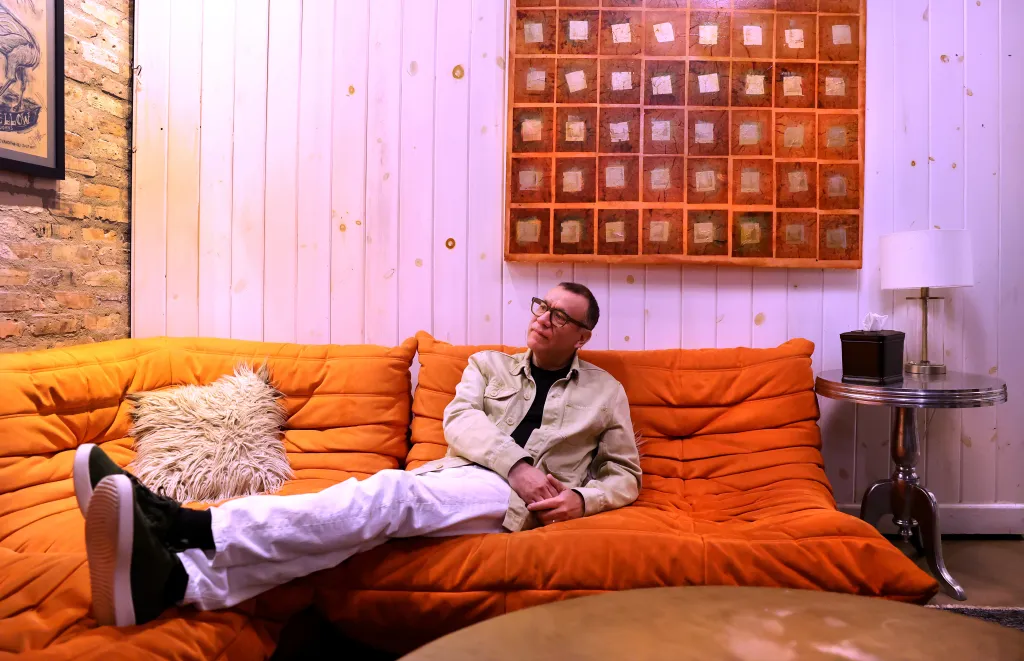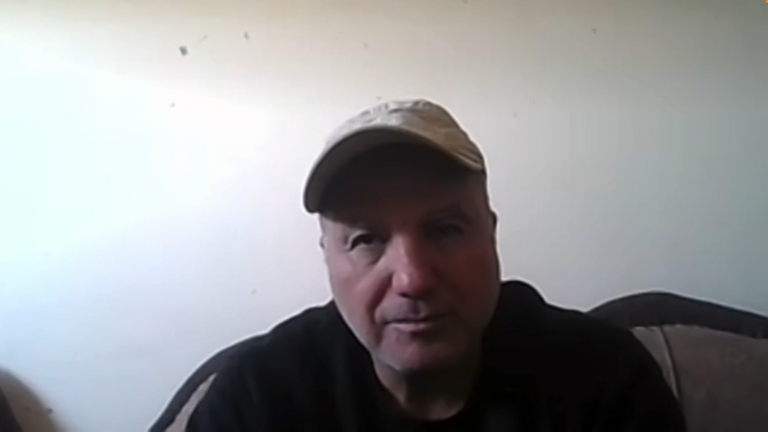Copyright Chicago Tribune

Evanston, on a supposedly quiet Monday morning, is noisier than you might think. “OK, what’s that guy so angry about?” Fred Armisen asked as a garbage truck barreled down Sherman Avenue. A moment later it was replaced by a Supreme Lobster truck, which didn’t honk or cry or creak or rumble but just kinda chugga-chugga-chugged alongside him, waiting at a red light. Armisen looked at the truck, and looked at me, stopped talking and waited a beat. Every sound registered, getting a slight eyebrow raise here, a slow head pivot there. Armisen, who is best known for his 11 seasons on “Saturday Night Live” and eight seasons of “Portlandia,” and now two seasons as Uncle Fester on “Wednesday,” is a sound guy at heart, in countless ways. You can hear the sound of his singular voice in your head and its hyper-articulate whine. Many of his best-known “SNL” creations — the Californians, the political comic who keeps interrupting himself and never makes a clear point — were defined largely by their voices. His stand-up comedy is partly a showcase for his drumming skills, and occasionally he joins Sleater-Kinney and Carrie Brownstein, his “Portlandia” co-creator, in concert. But also, he’s keenly attuned to many varieties of audience applause, and to the sound of a crowd when a performer’s microphone is not working, and to the sound of a theater ignoring a plea for quiet, and to the intensity of root vegetables being chopped in a movie that — he’s very specific — will win an Oscar. He can explain what a guitar store sounds like between Thanksgiving and Christmas. And the sound of someone opening their hotel mini-fridge and not removing anything. “But Chicago sounds …” he says, thinking about what sounds he connects to his former home, where he spent his formative 20s, as a doorman at the fabled Lounge Ax, as a Blue Man Group drummer, as drummer of the local progressive punk act Trenchmouth. Just then, two guys passed with a wireless speaker, blasting the rapper Key Glock. Armisen waited a moment and started again. “OK, specifically, when you’re downtown, you’re in the Loop, there’s no real sound of traffic, even if it’s busy. So you can hear people talking. It’s not quite all MEEP MEEP all the time. That feels like Chicago to me. Here’s a weird one: You know how it’s like in the dead of winter here after you’ve been to a restaurant and you’re in the city but it’s quiet outside because it’s too cold for people to linger? That cold silence, that sound of icy air — that’s extremely Chicago. Not a small-town sound, yet your own voice gets very loud.” As if on cue, a Purple Line train thudda-thudda-thudded past. Armisen leaned into my recorder: “OK, the interviewer has just pointed to the ‘L’ crossing through an overpass.” He leaned back. “The CTA is the most obvious Chicago sound of all, probably, right? But the other sound that I associate with living here is the sound of what you could call noise jazz. Some people think of that as more New York. But really, it’s a sound of improvisation, it’s the sound of the Art Ensemble of Chicago for one, it’s that highly experimental jazz that was happening here in the ‘90s, that screech from those high-pitched saxophones.” A stroller click-click-clicks by, softly riding every sidewalk break. Car brakes whine a block away. Armisen is so keyed into the rattle and hum of everyday sound he just released a record on Chicago’s Drag City that is exactly what its title implies, “100 Sound Effects.” Track No. 7 is “Music Venue Employee Kicking Everyone Out While Throwing Away Bottles.” Track No. 32 is “Fake Booing.” Track No. 40 is “Wine Glass Breaking.” Track No. 75 is “Basketball on Carpet.” Track No. 76 is “Signing a Basketball.” The first track is “Needle on Record,” and the 21-second final track is “Fred Walking to Control Room.” Exactly 19 tracks are dedicated to the many ways that an audience can sound: “I notice in movies or TV shows that whenever a band in the show is popular, the audience is waaaaaay too enthusiastic. It’s just not how real audiences sound. “On the other end, when you see footage from North Korea of a government event, the way they clap is very fearful and also supportive at the same time — and by the way, no offensive to the North Korean government. I mean, do they get the Tribune in North Korea?” Armisen dedicated “100 Sound Effects” to the late Chicago producer Steve Albini, who was a close friend for decades and died in 2024 at 61. “I wasn’t dedicating it to Steve to say, ‘Hey, you know Steve was so cool,’ but because he had literally facilitated this album. I had an admiration for his work ethic and how he recorded music but also because he was so funny, and when I was thinking of making a sound-effects record, when I realized I had to commit to it as a real project as opposed to something frivolous, I called him. Ideally I would record at Electrical Audio (Albini’s Avondale studio), but I don’t live in Chicago now. I asked Steve for a studio in Los Angeles and he suggested asking Dave Grohl, who hooked me up with the Foo Fighters’ studio and connected me to a producer (Darrel Thorp, known for his work with Radiohead, Paul McCartney and Beck). Steve was supportive in a real way. He loved the job of recording itself — that it didn’t have to be for a band, but it could be narration or sound effects or anything at all.” Armisen said that “100 Sound Effects” began nostalgically, as a memory of his years in Chicago. “I worked at Sound Warehouse on Clark Street, the old chain record store. I remember we would get these CDs of sound effects. They had their own little section.” A loud murmur-murmur of Northwestern students passes. “Anyway, it became this little tap on my shoulder. I had thought about making a record of just (stand-up) comedy covers. And I thought of an album of just bass. But I missed Halloween sound-effects albums, which were the most common sound-effects records.” I told him he can still find Halloween sounds 24/7 on satellite radio, but it’s often less innocent ghosts and rattling chains than full-blown SHREEKS and chainsaw GROWLS. “I’m with you, but in their defense, maybe they’re soundtracks for haunted houses?” Like the way NPR plays faintly in the background at used bookstores? “Oh! Exactly like that!” “100 Sound Effects” is not quite in the lineage of Yoko Ono and John Cage recordings or even Lou Reed’s “Metal Machine Music” — albums in which the star is not melody so much as concept. But it is conceptual in the sense that the very specific titles of several of the tracks — “Small Theater Audience at a Heavy Political Show,” “Camping Packing Up Conversation” — can come across as more substantial than the tracks themselves. There is a degree of comedy about this, of course, especially in a few homages to Halloween albums — for instance, “Haunted House Ghost Going Upstairs but the Door is Locked.” But mostly Armisen imagines it being picked up in 10 years by a film or TV sound person in need of, say, a sound of a door closing on a 1958 Ford, or a sound of obligatory applause. He imagines someone in 50 years finding it and hearing an odd aural time capsule of the early 21st century. He does not imagine it being played much. “I wanted this record to be that weird little record in your collection that nobody knows what it is. Really, I think I’m copying David Byrne sometimes, you know? That’s someone attuned to sound. He dedicated his life to sound… I have this feeling when I am talking to him, or someone like Mark Mothersbaugh (of Devo), a feeling of like ‘Remember me? Remember when I used to listen to you all the time? We’re old friends! I bought your record, I saw you at …’ I’m not delusional, but in a way I feel like we’ve always known each other, that there was a conversation going on. This record, I think, is kind of like a way of doing my part to make things and to contribute to that ongoing talk.” A truck braked and HOOOOOONKED. “What’s that about?” Armisen said, then: “I never realized how loud trucks are. Wait, I do know. Making this record was an education in how much noise is really out in the world.” cborrelli@chicagotribune.com



